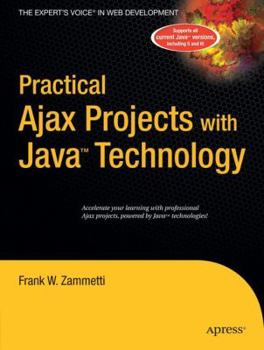Practical Ajax Projects with Java Technology (Practical)
Select Format
Select Condition 
Book Overview
This book will save Java developers countless hours of development time by providing them with seven complete Ajax applications to learn from and adapt for use in their own projects. The applicaions include an online calendaring/scheduling system, a Flickr(TM)-style photo gallery application, and an Ajax role-playing game. The book also details the set-up of a perfect Java/Ajax development environment in which to construct the applications; Java technologies covered include Apache, Ant, Ajax Tags, Struts, Prototype, DWR, Dojo, and more. This is the first book of its kind, aimed at Java/Ajax
Customer Reviews
Rated 4 starsGreat AJAX toolkit guide
Before you buy this book, you should have a solid understanding of basic Javascript and some server-side Java programming. The book does a great job explaining how to create complicated projects simply by using some of the free AJAX toolkits. My only complaint is that the book does not cover much "raw AJAX." If you are looking to learn how to use some of the best toolkits for AJAX programming, this is the book for you.
0Report
Rated 4 starsGood intro and reference material
The book begins a three chapter introduction about the involved technologies, Ajax basics and maybe even more important the concept of Web 2.0 and its ongoing evolution. When people think about Ajax they often think 'no refreshing', 'cool widgets' and 'flashy stuff', but nobody really thinks about desktop application architecture within the webbrowser. And Frank Zammetti finely points this out. The chapters following the...
0Report
Rated 4 starsA very nice complimentary resource
I have read some AJAX books and enjoyed them, but they typically concentrate on the client side and coverage of what occurs on the server side, if any, is generally PHP or a smattering of almost anything. But I'm a Java guy. The book I've been looking for would have not only the server side examples in Java, but would also use Java as the basis of discussion on client-server communication and the tools available to ease the...
0Report














